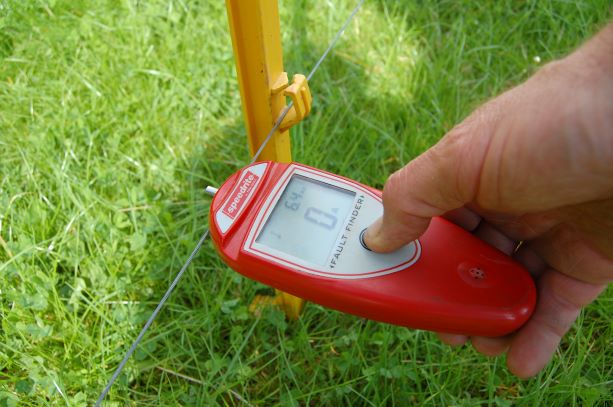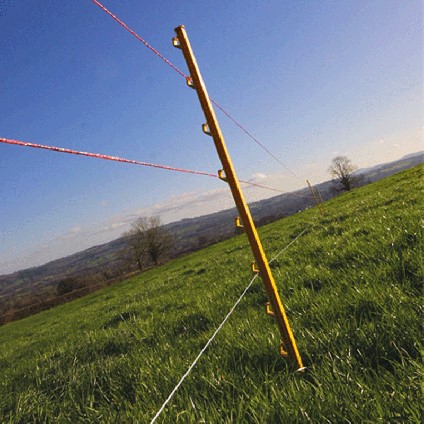- Home
- Knowledge library
- Components of an electric fence
Components of an electric fence
A good electric fence system requires a combination of components that all work efficiently together, including an energiser, a power source, an earth system, and a conductor.
Energiser
The energiser is the ‘powerhouse’ of an electric fence system. The energiser converts the mains or battery power into high voltage pulses of current, generally sent down the wire regularly every couple of seconds.
Energisers are power rated in joules, expressed as either ‘stored energy’ or ‘energy output’. It is best to look at the stored energy rating, as this remains constant. While fence length affects the energy rating, it isn’t affected by external conditions that may affect the pulse, such as poor earth grounding. The electricity must complete a full circle back to the charger through the ground.
Voltage is derived from the potential power output of the unit, but is also dependent on its power supply and the efficiency of the earth system.
In some situations, power requirement guidelines may seem excessive. However, supplying enough power is important so that the fence remains effective when faults occur, such as when grass touches the wire. This also makes sure livestock can detect the electrical field around the wire before they make contact with the fence.
When deciding on which type you need, consider how close the fence is to a mains supply, the length of fence and type of stock.
Top tips:
- Aim for a consistent output
- Calves or untrained cattle require 4,500–5,500 V
- You can use 3,500–4,500 V for trained cattle
- For sheep it depends on the amount of wool present, but generally 5,000 V to train them (4,000 V if shorn), reducing to 3,000–4,000 V once they are used to it
- Set up energisers in the middle of an electric fence system to reduce the risk of low voltage at the furthest points
- A lightning diverter will help protect the energiser if lightning strikes, preventing severe damage
One joule of stored power should be enough to power 5–6 miles of 2.5 mm diameter high tensile wire, or one mile of polywire at 4,500 V. Power requirement increases dramatically the more vegetation load placed on the fence.
Test fences regularly to measure the power running through the fence lines. Some fence testers can also identify where faults are occurring.

Power source
Mains
Running an energiser on mains power is usually the best choice, where possible, as it is cheaper than batteries and does not involve changing units. However, you will need an underground cable to connect a mains power energiser to the fence and earth posts. This can be expensive if it runs over long distances. If you are considering mains electricity, professional advice is essential – account for all risks and hazards.
Pros:
- Cheap to run
- No batteries to charge
- Only dependent on energiser for voltage
Cons:
- Can prove expensive to set up
- Not suited to areas with public access
Battery
Battery-powered energisers clip directly onto the fence and earth post, these can vary in power output. Always use a leisure or marine battery, as these are designed to cope with deep discharge/recharge cycles and will give greater life than automotive types.
Pros:
- Better suited to temporary fencing
- Portable
- Can be cheaper to set up
Cons:
- Greater running costs
- Batteries need replacing
To prolong a battery’s lifespan, try to avoid temperature fluctuations. Keep the battery in an old cooler box when possible.
Solar
Solar panels generate power by converting sunlight into electricity, which is then stored in a battery. Solar-powered units offer an alternative power source in more remote locations.
Make sure the panel is in optimum position and angle to convert sunlight to electricity. To avoid damage to the battery by excessive amounts of power on hot sunny days, fit with a regulator.
Select the battery type and capacity (amp hours) carefully to complement the solar panel unit – consider a deep cycle (leisure or marine) battery. Choose a battery that contains enough capacity to provide reliable power to the energiser during winter or in reduced light conditions.
Pros:
- Running costs can be cheaper than conventional batteries
- No requirement to remember replacement batteries
Cons:
- More expensive than battery-only systems
- Influenced by weather and season
Earth system
The earth system is as important as the layout of the whole fence, as it allows the power to flow around the fence. If the earth system is efficient, when an animal touches the wire it will produce a shock and then allow the flow of electricity back to the energiser.
The depth of the earth rod in the ground is dependent on its conductivity/surface area and the moisture of the soil. Small diameter rods in dry soils need to go deeper than larger diameter rods in wet ground. In UK conditions, a 16 mm copper-coated steel rod generally needs to be at a depth of 30–40 cm/joule of energy, but may need to go deeper depending on how dry the soil is.
Larger systems
If you have a larger system, (e.g. using a five-joule energiser) you’ll need two metres of earth. Place stakes at least four metres apart and link with the underground cable, which is connected to the energiser’s earth terminal. Ideally, the earth stakes should be in a damp site.
You may need to treat the grass under the fence line to stop contact with the wire. However, this is only practical if it is a permanent fence or on lines where you are regularly setting up temporary fences.
Testing the earth system
There are two alternative methods to test the earth system:
- Short the fence by placing an iron bar across the wire to the ground at least 100 m from the earth system. A tester should indicate a figure near zero; anything reading above 200 V needs more earth stakes.
- Dig a trench at least one metre deep and bury a copperbond or stainless-steel rod of appropriate length. This guarantees consistent contact with damp soil, over the entire rod length. Depending on your soil type and system, the requirement is roughly 25 cm of earthing rod length per joule of energiser power output.
Conductor
You can use different types of wire or conductor to conduct the electricity along the fence line:
Steel wire
Single or multistrand steel wire is strong, durable and effective at conducting electricity, but is heavier than other alternatives. This type is most suitable for permanent and semi-permanent fencing.
The steel wire should be high tensile not mild steel, as this has minimal length change with temperature, which ensures consistent fence tension and wire height. When power needs to be supplied a long distance (>6 miles), use wire of 2.5 mm diameter. For shorter distances (<6 miles), 1.6 mm diameter wire is suitable as it is lighter. This means you can extend post spacing to reduce the cost.

Polywire
Polywire is a polythene twine with interwoven filaments of stainless-steel wire. This is lighter and more commonly used in temporary fencing systems, but can also be used in permanent fencing.
Polytape and polybraid
Both contain steel wires inside polythene in a ribbon. These come in different widths and colours and are often easier to see but can be prone to damage in high winds. You can use these for permanent and temporary fencing.
Electrified netting
Netting is available in a range of mesh sizes for different types of stock. This type is most suitable for temporary or strip grazing with young lambs/calves, or as a training aid.
Reels
Geared reels significantly reduce the time it takes to dismantle a fence.
A reel post allows the fence wires to be independently tensioned and it also keeps the wire fence taut. There is a wide range of different reels available to suit different systems.

Posts and stakes
Permanent electric fence systems commonly use wooden posts with insulators attached to them. Temporary fences use metal, fibreglass or plastic stakes. The latter two types are insulating, which can be easier to handle and will not short out the fence if they contact a live wire. Sometimes, polywire or multistrand steel wire can fray. If these make contact with the metal posts, it can cause the fence to short.
Fences require stronger anchor posts at the end and corners to help take the strain. For temporary fencing with frequent moves, place posts at regular intervals, depending on the class of stock. For sheep and calves, 12–20 metre intervals are good and for cattle 15–25 metres intervals should work fine.
With an electric fence, trained animals will not challenge the fence as long as the wires are at the correct height – posts must be spaced to maintain wire at the optimum height. This can mean spacing of up to 25 metres on flat ground but can sometimes be as little as four metres on rolling ground.
Insulators
Use insulators to prevent the conductor or wire touching the posts or stakes, which could lead to power leakage. Special anchor insulators are for the end of fence lines or around corners.
The insulators should be smooth and dry easily so moisture does not collect, as this can cause arching, which reduces the effectiveness of the electric fence.


